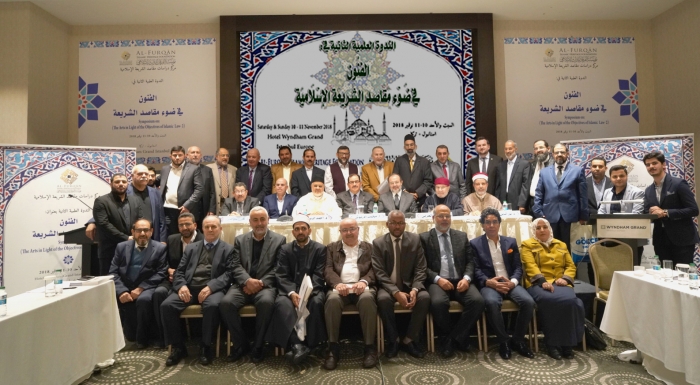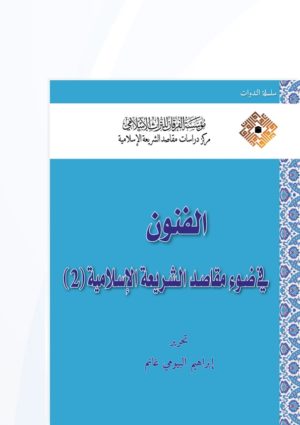The Centre for the Study of the Philosophy of Islamic Law at Al-Furqān Islamic Heritage Foundation organised a symposium titled “Arts in Light of the Objectives (Maqāṣid) of Islamic Law”, which took place on 10 - 11 November 2018, at the Grand Istanbul Europe Hotel. This was a follow-on from a previous symposium held two years ago on the same topic, given the participants’ consensus to continue the study of this novel and beneficial subject, founded on an objectives- and knowledge-based vision, in response to the requirements of Islamic law and demands of time.

Preliminary Session
The Preliminary Session, chaired by Dr Ahmad al-Raissouni, was opened with a recitation of some illuminating verses from the Noble Qur’ān, recited by Dr Wasfy Ashour Abu Zayd. Mr Sali Shahsivari, Managing Director of Al-Furqān, followed with a speech, in which he greeted the esteemed scholars, expressing the Foundation’s warm welcome, and that of its patron and founder, Sheikh Ahmed Zaki Yamani. Mr Shahsivari focused on explaining the importance of the topic at hand, and the research approaches that were adopting the lens of Islamic law’s objectives. He also emphasised that the arts were a perennial human necessity, playing a significant role in directing societies. For this reason, Al-Furqān Foundation had resolved to address the matter from an objectives-based perspective, in continuation of the previous symposium. He drew attention to those trends promoting destructive ideas in the name of art, remarking that, it was therefore incumbent on scholars and researchers to shed light on the arts from the perspective of Islamic law objectives, and correct many concepts ingrained in the minds of Muslims around the arts; moreover, to offer ideas and practical solutions in the diverse art domains that serve as guiding light for workers in these areas. He noted that this Symposium is distinguished by the attendance of a blessed company of artists and specialists. He ended by expressing his heartfelt appreciation and gratitude to the esteemed scholars, intellectuals, and both the Review Panel and Organising Committee; moreover, commending the efforts of Mr Mohammed Drioueche, and his effective role in holding these events, and thanking the media persons in attendance.
The next speech by Dr Rateb al-Nabulsi sought to illustrate that art was the aesthetic aspect of the human dimension. He highlighted that art could be a weapon with double-sided edges. He indicated by way of example that an American study of cartoon films had demonstrated that these types of films spread unbelief, and misrepresent religion, especially Islam.
Subsequently, Dr Mehmet Görmez, former President of the Presidency of Religious Affairs in Turkey, thanked the attending scholars and Al-Furqān Foundation, welcoming them to Istanbul, which he noted was the meeting place of cultures. He also highlighted the role of reformist and righteous scholars, and explained that arts are one of the key interests of civilisation. He elucidated that the topic of art must be treated through the objectives-based approach, in accordance with the Intent of God Almighty, such as through the objectives of social advancement and civilisation (al-‘umrān) and the objectives of legal charge or responsibility (taklīf). He alluded to the fact that the improvements (al-taḥsīniyyāt)—in their widest reach—are the most maligned and depressed branch of our thought, as we have failed to grant it its deserved place.
Dr Issam al-Bashir then spoke emphasising the necessity of widening universal rational consideration into the arts sphere, such that it is laid on a foundation of beauty based on the creed of monotheism (tawḥīd), and purification (tazkiyyah) based on values. He drew attention to the fact that it was important to rise above the limited view of arts and embrace the wider horizon of civilisational consideration. He explained that the arts domain had suffered from deviance and excess, transporting it into the domain of negativity and servility. He concluded by saying that the juristic study of the arts must not be limited to referral to the principal sources of Islam, i.e. ta’ṣīl, but must also seek to find alternatives. Moreover, taste, audition, etc. are the constituents of art, where all the arts are founded on the values of beauty so as to be fit for purpose in securing a civilisational leap forward.
First Session
Dr Issam Al-Bashir chaired the First Session, which began with the paper by Dr Noureddine al-Khadimi titled “Arts and legal theory: the legal principles expressing the arts, and the arts expressing legal principles (al-funūn wa al-uṣūl: al-uṣūl al-mu‘abbirah ‘an al-funūn wa al-funūn al-mu‘abbirah ‘an al-uṣūl)”. In his presentation, Dr Khadimi emphasised the dialectic relationship between legal theory and the arts, arguing that legal theory principles were serviced by the arts, while the arts were also stimulated by these principles. He proceeded to illustrate this on three axes:
First: the process of framing the legal rulings relating to the arts, through the discourse of legal charge (taklīf) and the discourse of application (al-wad‘). The former relates to establishment, while the latter relates to the application within context, time, rationale, obstacles, and circumstances. He then demonstrated the framing of the arts by legal theory universal evidences; he linked this with the evidence from the Revelation, namely the Noble Qur’ān and Prophetic Sunnah, and evidence through creative juristic effort (ijtihād), which is concerned with securing application through comprehending the effective cause (taḥqīq al-manāṭ), considering the consequence (i‘tibār al-ma’āl), and other methods.
Second: in which he addressed two issues, namely the means for expressing legal theory principles, where he indicated the forms of artistic expression, such as storytelling, theatre, poetry, image and others. Furthermore, the rules for artistic expression of legal theory principles, which he expressed as the rules governing values in the religious, human, scientific objectivity, artistic, constitutional, and customary dimensions… including those rules imposed by sound primordial human nature (al-fiṭrah), public order, and common benefit.
Third: what he termed the legal theory and arts dialectic, in the journey from referral to principal sources to stimulation of the arts. Here he attempted to explain two issues: the first, related to establishing the textual evidence base of awareness of the legal principles of the arts; he posited that legal theory has a connection with the arts through conferring the practical and creative juristic legislative view; the second, related to establishing the textual evidence base of awareness of the arts of legal theory, which is linked to the means in the arts that achieve legal theory principles.
This paper was reviewed by Dr Salim Abdel Salam al-Sheikhy. The commentary was delivered on his behalf by Dr Jasser Auda, beginning by what Dr al-Sheikhy termed key introductions, where he focused on the objectives-based, scientific methodological issue of the relationship of arts to legal theory. He explained that the paper is distinguished by originality in aspects, and is quite beneficial in some content. However, he observed that it had not been fully matured, and was characterised by generalities, especially in some methodological notions. Moreover, it was filled with synonyms and digressions, resulting in ambiguity, with absence of the intended.
Subsequently, Dr Idham Mohammed Hanash delivered his contribution titled “The Qur’ān’s aesthetic objectives and their knowledge manifestations in the Islamic arts (Maqāṣid al-Qur’ān al-jamāliyyah wa tamaththulātuhā al-ma‘rifiyyah fī al-funūn al-Islāmiyyah)”. He began by discussing what he called the three-dimensional framework presented by al-Shāṭibī and others, namely that of necessities (ḍarūriyyāt), needs (ḥājiyyāt), and improvements (taḥsīniyyāt) or luxuries (kamāliyyāt). He then proceeded to classify objectives, by philosophical value and weight, into divine (ḥaqāniyyah), promoting good (khayriyyah), and aesthetic (jamāliyyah); in his view, the last relates to the natural human form, or the primordial human nature (al-fiṭrah).
Following that, he proceeded to treat the objectives-based classification of Islamic arts into:
· Divine arts related to the (principal) Qur’ānic objectives, such as monotheism (tawḥīd), and belief (īmān); for example, the arts of Qur’ān calligraphy (al-khaṭ) and Qur’ān copy or Muṣḥaf illumination (tadhhīb).
· Divine aesthetic arts related to the Qur’ānic objectives of social and civilizational advancement (al-‘umrān); for example, the art of (mosque) architecture, and decorative art.
· Aesthetic arts related to the (branch) Qur’ānic objectives of social and civilizational advancement (al-‘umrān); for example, arts of depiction (drawing, sculpture, and design).
He then concluded that beauty is a principal (aṣlī), universal (kullī), and fundamental (asāsī) objective, and art is a partial (juz’ī), and complementary (takmīlī) branch objective; yet, both must be considered through the perspective of the mapping of objectives into necessities, needs, and improvements.
Dr Jasser Auda reviewed the paper, where he focused on looking beyond specialisms and approaches in the study of artistic phenomena. He considered these phenomena as multidisciplinary, and as such closest to the Qur’ān, because it treats them across their numerous dimensions.
Second Session
The Second Session, chaired by Dr Saifuddin Abd al-Fattah, followed these two presentations and reviews. Dr Salah al-Din Shirzad presented his paper titled “The Islamic-ness of Islamic arts between theoretical knowledge and procedural application (Islāmiyyat al-funūn al-Islāmiyyah bayn al-tanẓīr al-ma‘rifī wa al-taṭbīq al-ijrā’ī)”. In the beginning of the paper, he raised the issue of the term Islamic-ness of the arts, arguing that writings in this area had appeared quite late, influenced by western writings that had first set the standard. Indeed, while Muslims had been pioneering in the practice of a majority of arts, they had not documented these in the contemporary sense of classification, until about a century ago.
Dr Salah emphasised that research in the arts had taken bibliographic and historical directions, where it was clear that it included many specialisations. He considered that a set of problematic issues relating to theorising and procedural application needed to be addressed to resolve the problem of the term “Islamic arts”.
Dr Abdullatif Bouazizi expanded in his review of the paper with remarks on methodology revolving around the inexact title. He noted that the content was intended to demonstrate the extent to which arts that may correctly be described as “Islamic” exist. However, as the author explored the correctness of this terminology, he chose to exclude the literary arts, which was questionable, and resulted in the paper lacking depth in some aspects.
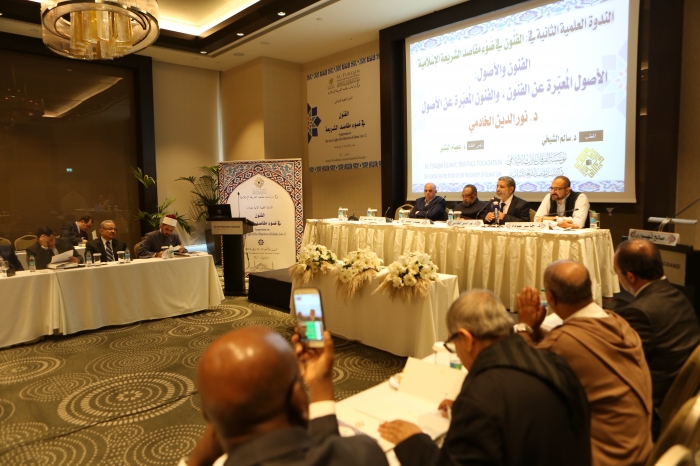
The reviewer then pointed to some terms that could benefit from greater rigour and precision. He asked whether the ruling on the extent of Islamic-ness of an art was based on its origins, functions, or consequences? However, the researcher’s conceptualisation of the Islamic-ness of art only seems true for Arabic calligraphy. Dr Bouazizi then explained that the paper had considered form in the Western approach, while it should have been concerned with the ideological, belief, and legislative background.
Dr Bouazizi also pointed out that the researcher had focused on the functional classification, neglecting others, such as the historical or geographical ones. He concluded his review by observing that judging the Islamic-ness of the arts depends on how far they stem from the spirit and objectives of Islamic law, as well as complying with the Qur’ān text and rulings, while being influenced by its spirit and approach.
Dr Mehmet Görmez followed with his paper, “The improvements in objectives: the philosophy of beauty and art as an example (al-taḥsīniyyāt fī al-maqāṣid: falsafat al-jamāl wa al-fann namuwdhajan)”. He underscored the importance of the discipline of objectives and desired outcomes (ghāyāt), in that it covers all the Islamic sciences, and indeed, life in its entirety. Dr Görmez asked: have we not consigned the discipline of objectives to a narrow space, to the point of making it a mere branch of the Islamic law sciences?
He spoke of five fundamental types of objectives, namely those of creation (takwīn), civilizational and social advancement (‘umrān), real-life application (tanzīl), and finally, the objectives of legislation (tashrī‘), and legal charge (taklīf). He then demonstrated the flawed treatment of the tripartite division of benefit (maṣlaḥah) into necessities, needs, and improvements. He mentioned that we have treated improvements over a prolonged time as secondary, extra, or complementary, and hence, unimportant. He argued that the marginalisation of improvements from the perspective of Islamic thought is a crime that leads to loss of beauty and vitality. From that viewpoint, Dr Görmez called for a wider conceptualisation of improvements to include all facets and aspects of life, making the relationship of improvements to necessities and needs like that of voluntary ritual (sunan) to the obligatory (farā’iḍ) and duties (wājibāt), respectively.
He called for restoring the concept of improvements in status, releasing it from the enforced restriction. He concluded his paper by highlighting the conflict involving culture and identity, where revival required re-examining various issues, including the improvements, in that these are not meaningless extras.
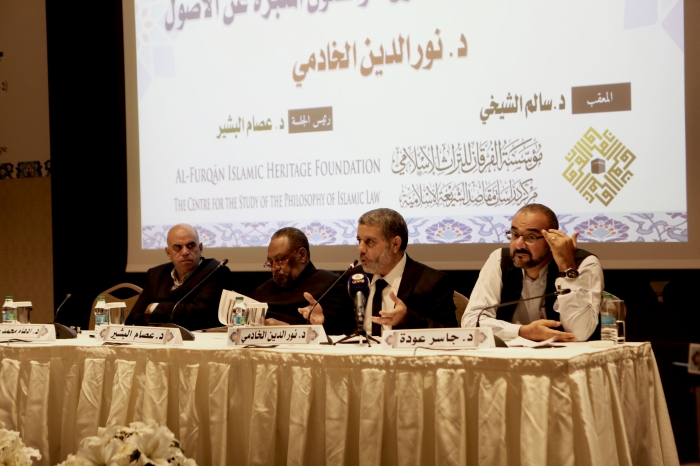
Third Session
Dr Noureddine al-Khadimi presided over the third symposium session, which began with Dr Ammarah Kuhli’s paper titled “Reflections on the objectives-based contexts of Islamic beauty: an interpretive approach of Islamic art in light of contemporary texts (ta’amulāt fī al-siyāqāt al-maqṣadiyyah li al-jamāl al-Islāmī: muqārabah ta’wīliyyah li al-fann al-Islāmī fī ḍū’ nuṣūṣ mu‘āṣirah)”. She addressed the issue of the aesthetic discourse of Islamic art, focused on the reflections of some thinkers, who had explored the concept of “Islamic art”; for example, the book “Aesthetics of vision: reflections in the visual spaces of Arab art (jamāliyāt al-ru’yah: ta’amulāt fī al-faḍā’āt al-baṣariyyah li al-fann al-‘Arabī)” by Rateb Mazid al-Ghawthani, “Islamic art in Arab sources: the craft of decoration and beauty (al-fann al-Islāmī fī al-maṣādir al-‘Arabiyyah: ṣinā‘at al-zīnah wa al-jamāl)” by Sharbal Daghir, and “Principles in the aesthetics of Islamic arts (uṣūl fī jamāliyyāt al-funūn al-Islāmiyyah)” by Mohammad Iqbal al-Arawi. She justified her choice in that all these authors had applied a “methodological concept altogether different to the classical basics agreed upon for the term Islamic art”.
Dr Kuhli specified the aim of her research as “referring to principal sources the knowledge and aesthetic content of our heritage writings” that explored Islamic art, to reveal “the objectives-based contexts of Islamic beauty”. She concluded that art has become a necessity from the objectives-based perspective in the Muslim’s life, and no longer a dispensable luxury.
Dr Hasan Jabir commented on the paper, pointing out that the paper’s title was not well-formed, while the authors adopted in the study were not unified in topic. As such, it is difficult to describe them as a single trend. Indeed, it would have served the researcher better to select two closely-related books and provide narrative describing an artistic experience.
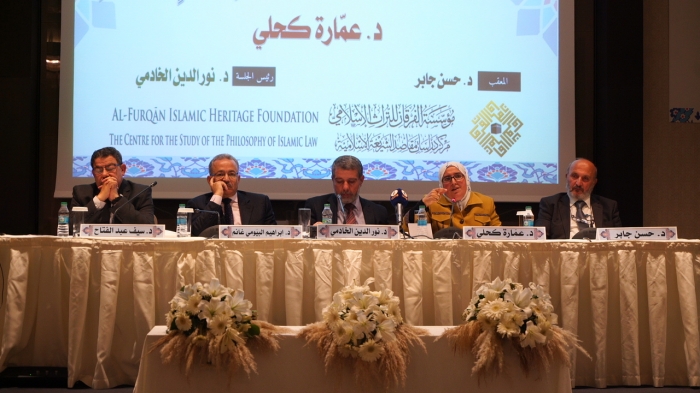
Dr Jabir also observed that the content was somewhat lax in referencing some verses of Qur’ān, such as: “And horses, mules and donkeys for you to ride and adornment (wa al-khayl wa al-bighāl wa al-ḥamīr li tarkabūhā wa zīnah)”, which presents in the context of the benefits of these creatures, and is not related to legislation.
Subsequently, Dr Ibrahim Bayoumi Ghanem presented his paper on “The objectives of architectural arts in the Islamic city: a reading into heritage texts and a view into contemporary reality (maqāṣid al-funūn al-al-‘umrāniyyah fī al-madīnah Islāmiyyah: qirā’ah fī nuṣūṣ turāthiyyah wa ru’yah fī al-wāqi‘ al-mu‘āṣir)”. In the introduction, he illustrated the origin of the Islamic city, which in his words was linked to the “root transformation brought by Islam to the way of life”. He then alluded to urban expansion based on the general objectives of Islamic law. This appeared through the arts of urban planning of the city, and in the division of its areas and public facilities. Moreover, in the employment of geometric aesthetics in constructing buildings and decorating public spaces and facilities.
From the perspective of the socio-political congress of the city, Dr Ibrahim Bayoumi Ghanem discussed how the grand aesthetic features and arts of the city were brought into relief based on Islamic law perspectives. Indeed, it formed the general domain embodied in the existence of arts and aesthetics in the design and planning of the city initially, to grow and fulfil these functions. As such, the public sphere characterised by openness became one of the most important conditions of decent life (al-ḥayāt al-ṭayyibah).
Subsequently, Dr Ibrahim Bayoumi Ghanem posed a fundamental and problematic question on the architectural and urban aesthetic principles governing the Islamic city of old, and why these were now absent in the public sphere? He linked this problematic matter to the issue of the relationship between political authority and society. He then clarified the key aesthetic and architectural values of the Islamic city. He concluded his paper with a conceptual vision that interprets the reasons for the deterioration in arts and aesthetics in the public space as witnessed in the reality of new cities in the countries of the Islamic world.
Dr Saifuddin Abd al-Fattah commented on this paper, beginning by explaining that the significant reading is one that is based on constructed models, and hence, departs from a holistic view. In this approach, there are standards to be observed; these include the standard of model-based reading, and the standard of the objectives-based vision. He then pointed to the changes and problems that Islamic cities have suffered in the alteration of urban identity. Dr Saifuddin Abd al-Fattah then explained that the Islamic law objectives had contributed to building these aesthetic arts, exemplified in the aesthetic design of the city based on Islamic law universals.
The reviewer also emphasised the important matter that he had extracted from contemplation of the Qur’ān verse (disperse within the land, “fantashirū fī al-arḍ”). This signifies dispersal and spread in terms of urban expansion and construction, while necessities, needs and others are formed through the urbanisation of the city and the application of the objective of social and civilisational advancement (‘umrān). Indeed, the dominance of western models in application has led to architectural chaos, as the Western-style does not correspond to Islamic needs, leading to unrepresentative building, which signifies loss of civilisational and architectural balances.
Session Four
Session Four chaired by Dr Hassan Jabir convened on Sunday. Dr Abdel Malek Boumanjal presented a paper on “The functions of the literary arts in light of the Islamic law objectives (waẓāif al-funūn al-adabiyyah fī ḍū’ maqāṣid al-sharī‘ah al-Islāmiyyah)”. He began by illustrating that Islam is the religion of the primordial human nature (al-fiṭrah), which is naturally inclined towards beauty, because Islam, in his words “is the perfect, comprehensive religion of beauty”. It elevates the human being in his way of life, where he strives for beauty in all affairs, in outward appearance (ẓāhir) and inner self (bāṭin), emotion and behaviour, speech and silence, and activity and inactivity.
Dr Boumanjal referred to the concept of beauty, and the relationship between Islam and beauty to the principal sources. He then illustrated the connection of beauty to man's humanity, and emphasised that Islam's objectives do not contradict any of the objectives of human literary activity. Dr Boumanjal focused in his paper on the literary arts, considering that these are spoken arts that utilise the power of words in capturing human emotions through the beauty of imagery, sweetness of rhythm, vitality of flow, strength of idea, cleverness of crafting, refinement of meaning, and robustness of constructs.
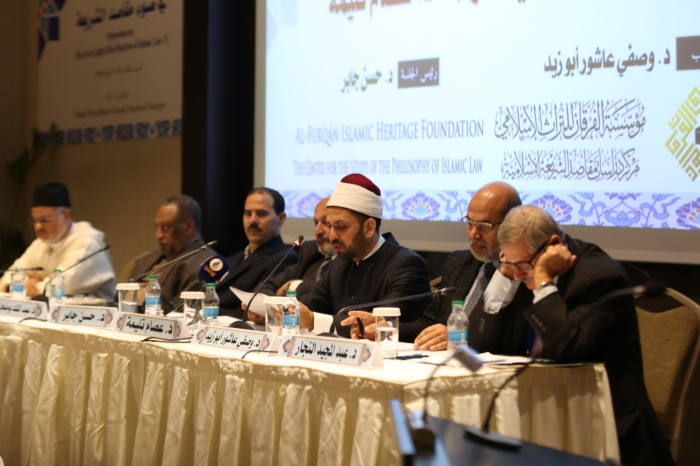
Dr Boumanjal explained that Islam has greater claim to beauty than other religions, as it invests in the word as a means of satisfying the emotions, and adding an atmosphere of joy to life so that it is in the service of the grand vital interests of the human being, not to corrupt or bring unhappiness. He then addressed the nature of the literary arts, in terms of substance, characteristics, motives, and aims. He discussed these in light of the referral to principal sources undertaken by Islamic scholars from the perspective of Islamic law objectives. In his submission, he discussed the grand theories in the domain of literary arts.
Dr Issam al-Bashir commented on this paper, and began by praising the work in terms of its foundation on a clear methodology, where it addressed, in order, the lyric genre, rhetoric, and narrative. He expressed his satisfaction with the methodological order applied to this issue.
Dr Issam al-Bashir then made some observations, namely the mutuality between the outer and inner, as there is no contradiction between them. This is clearly illustrated in the Noble Qur’ān, where he quoted the verses: “O you who covers himself [with a garment]. Arise and warn. And your Lord glorify. And your clothing purify… (Yā ayyuha al-muddathir. Qum fa andhir. Wa Rabbaka fa kabbir. Wa thiyābaka fa ṭahir…)”. This describes the mutual relationship between form and substance, and inner and outer self. Dr Issam al-Bashir then explained that the Noble Qur’ān pointed to the material benefits of existence, and enjoyment of the aesthetic values. He evidenced this from the Noble verse “And horses, mules and donkeys for you to ride… (wa al-khayl wa al-bighāl wa al-ḥamīr li tarkabūhā…)”, which indicated deriving material benefit, while “… and adornment (… wa zīnah)” indicated the aesthetic and artistic benefit.
Dr Issam al-Bashir then moved on to illustrate that art is interspersed within all levels of Islamic law from necessities, needs, and improvements, dependent on circumstances and consequences. Therefore, beauty in spirit and taste are essential, without which life would not be proper or tolerable.
He then spoke of the rhetoric and eloquence of the word and its huge influence; indeed, he stated that he disagreed with the paper’s author on the idea of not burdening poetry with the moral dimensions, considering that poetry must carry the responsibility of safeguarding moral values. Subsequently, he indicated a type of contemporary speech appearing in the art of short tweets, such that it has an effect on the human spirit and current reality.
He concluded his commentary by mentioning some governing rules, namely the requirement for: credibility, elevated and noble content (“In their stories, there was indeed a lesson for those of understanding”) [quoting the Qur’ān], rising above injuries, and connecting form and substance.
The paper by Dr Jamil Hamdawi followed, titled “Islamic theatre according to the objective-based trend (al-maṣraḥ al-Islāmī wifq al-nasaq al-maqāṣidī)”. This was graciously read out on his behalf by Dr Essam Talimah. The introduction explored the difficulty and sensitivity surrounding research on the topic of art. As a result, opinion was divided between those rejecting it, either on the basis of it being detested (makrūh) or prohibited (ḥarām), or accepting it, either on the basis of it being obligatory (iyjāb) or allowed (jawāz); this included the art of theatre.
The researcher proceeded to explain the different views and conceptions of the theatre, from the open-minded, technical, objectives-based view represented by both Dr Najib al-Kaylani and Dr Imad al-Din Khalil, to the festival-based heritage view that was the basis for Abdel Karim Barshid and Izzuldin Madani; the moderate, legislative, juristic viewpoint espoused by Dr Ahmad al-Raisouni, Dr Yusuf al-Qaradawi, Dr Mohamed Amarah, which contrasted with the strict juristic viewpoint based on prohibition and rejection adopted by Dr Ahmad bin Siddiq, Dr Mohammad al-Zamzami, and the Sudanese researcher, Tahir Dafallah.
Dr Wasfy Ashour Abu Zayd commented on the paper alluding to the fact that the aim was a position paper on Islamic viewpoints on theatre. He noted that the researcher had limited himself to mentioning the opinions of Maghreb scholars, such as Dr al-Ghimari and Dr Raisouni, as well as others, with the exception of Tahir al-Sudani, but had neglected others, who had also prohibited theatre, and this was a shortcoming.
The reviewer opined that expanding the civilisational horizons and securing the resurgence of the Muslim nation must be accomplished through this and other types of arts, and should not be restricted to exploring the juristic ruling only. Furthermore, while the moral and ethical dimension was prominent in the treatment, less prominent was the objectives-based dimension. Dr Wasfy mentioned that Shaykh Yusuf al-Qaradawi had addressed the arts in his writings in both aspects of juristic rulings and objectives; however, the researcher had not mentioned his opinions extensively. On the other hand, Dr Ahmad al-Raisouni had not published a work dedicated to theatre, but had treated art in general. Moreover, Dr Wasfy mentioned that some notable personalities, such as Mohamed Amarah and Dr Yusuf al-Qaradawi, were absent from the paper, bearing in mind that they had both explored theatre in their writings. He concluded his commentary by coining the phrase: “inviting to the glorious religion through the means of rising art”.
Subsequently, Dr Abdul Majeed al-Najjar presented his paper titled “The objectives of art in elevating belief (maqāṣid al-fan fī tarqiyyat al-īmān)”. At the beginning of the paper, he addressed the meaning of belief, namely the belief rooted within the heart in all that was brought by the Messenger, peace be upon him, connected to the practical aspects of behaviour. He explained that the strength and weakness of belief, or indeed, its rise or decline have an effect on the human mind and free will. This is the effective cause (manāṭ) of the legal charge (taklīf) relating to belief. In exploring this issue, he concluded that belief is elevated through reflection on God’s signs, whether presented in transcribed revelation or witnessed in creation; in the reflection on the phenomena of God’s creation, leading to the firm conviction in the Creator, and on to living according to the divine commands and prohibition. This was emphasised by many verses of the Noble Qur’ān.
He then turned to the matter of reflecting on the beauty of the creation, and the intrinsic harmony and consistency in sizes and colours, proportion between notes and sounds, and the composition of phrases and words, which invokes feelings and engages the senses in the expression of beauty. Dr Al-Najjar concluded that art is the expression of beauty, for which many verses advocated, inviting to reflection on the signs of beauty, whether images or sounds, or indeed, composed words. The objective, as Dr Al-Najjar determined, was to elevate belief.
Dr Ahmed al-Raisouni commented on the paper, explaining that it had contributed to attemping to correct the meaning of the concept of art, by elevating it and expanding its functions and objectives. This was apparent from several elements, of which he mentioned: highlighting the artistic dimension of religion, or indeed, correcting the perspective on the relationship of religion to art. Moreover, that refined and high art is part of religion. Furthermore, bringing into prominence the artistic and aesthetic dimensions of the phenomena and signs in creation, as portrayed in the Noble Qur’ān. In addition, underscoring the aesthetic of artistic elements in the Noble Qur’ān, and their role in the acquisition of belief. Finally, highlighting the artistic elements in the Noble Qur’ān, and demonstrating their effect in the development of the environmental and aesthetic sense.
Dr Ahmed al-Raisouni mentioned that the paper possessed another aspect, in providing an implicit answer to the issue of whether art was endowed with a mission or neutral. He then indicated that the topic of Dr Al-Najjar’s paper was to connect religion and art, more specifically belief and art. In the words of the reviewer, this is an area of perfection that few have explored or researched, and therefore, this paper had shed light on a number of hitherto neglected angles.
Dr Raisouni suggested that the paper’s author should include the pioneering work of the late Sayyid Qutb, God’s Mercy upon him, especially his unique work “Artistic depiction in the Qur’ān (al-taṣwīr al-fannī fī al-Qur’ān)”. He drew attention to the fact that Sayyid Qutb was quite notably present, yet conspicuously absent; present in the flow of his spirit, and the essence of his idea and theory within the paper, and absent because he was not at all mentioned nor quoted within. Dr Raisouni emphasised that it was impossible to overlook Sayyid Qutb within this topic area.
Dr Raisouni concluded his commentary by noting that the title of the paper “The objectives of art in the elevation of belief” is both quite general and broad, while the paper confined itself to the aesthetic aspect of creation within the Noble Qur’ān. He suggested the addition of examples of human arts, both Islamic and non-Islamic, which had served belief and religious devotion. However, if the paper was to remain unchanged, then Dr Raisouni proposed a change to its title to something more suitable, namely “The objectives of art in the elevation of belief: examples from the Noble Qur’ān (maqāṣid al-fan fī tarqiyat al-īmān: namādhij min al-Qur’ān al-Karīm)”.
Closing Session

The session was chaired by Mr Mohammed Drioueche, who explained the importance of this symposium on “the arts in light of the objectives of Islamic law”. Furthermore, he emphasised that the need was pressing for such a symposium from the perspective of religion, society, and civilisation. He praised the efforts of the esteemed scholars and researchers in making the symposium successful, by virtue of their ideas, discussion, and interaction, and given the presence of distinguished and renowned artists. He thanked them for this, and commended the efforts of Mr Sali Shahsivari, Managing Director of Al-Furqān Islamic Heritage Foundation, in convening this symposium, as well as expressing his gratitude to the symposium’s Organising Committee.
He then gave the respected and renowned artist, Mr Wajdi al-Arabi, the opportunity to address the audience. Mr Wajdi al-Arabi emphasised that religion had come to preserve the necessities, and that refined and principled art is one that serves these necessities. He explained that art is most beautiful when applied to the service of society, and in the defence of its issues, where it confronts excess, ignorance, corruption, and authoritarianism, as well as combating moral corruption. He emphasised that art cannot be called art if it is twisted into one misguiding believers. Indeed, art brings life to the necessities, and does not lead to their detriment. He warned that the Muslim nation’s enemies had taken control of the sources of enlightenment within it; in addition, he addressed practitioners of art, calling on them to fear God.
He was followed by Mr Mohammed Nasir, who emphasised the importance of the arts in serving society, and that refined and elevated arts do not conflict with religion, rather they are at its core. Mr Nasir projected a set of art images on the screen, highlighting their artistic and aesthetic importance. He also pointed out that calligraphy possesses its unique reading, where its horizontality represents elevation and zeal, while waviness represents instability and decline. This is an artistic, psychological and sociological reading of the art, which is expressive of societies and civilisations.
He ended his speech with a short audio of verses from the Noble Qur’ān, recited by the late Siddiq Minshawi, God’s Mercy upon him, where he highlighted the diversity of reading, and aesthetics of voice and its variations, from Bayati and others.
Dr Ahmed al-Raisouni then emphasised the necessity of overcoming the tendency of over-exploring the issue of definition and terminology, singling out the term Islamic arts. Indeed, there was no need to deny its existence, given that Islamic art is one that launches from the Islamic knowledge-based viewpoint on creation and existence; one that grants Islamic art its distinctive characteristics and features. Dr Raisouni called for greater participation of arts experts, and that they be granted priority over Islamic law sciences practitioners. Indeed, it was sufficient for Islamic law scholars to act as commentators and guides, based on the spirit and objectives of Islamic law.
Subsequently, in the name of the participants, Dr Nourredine al-Khadimi read out the symposium closing statement. He began by expressing gratitude and appreciation for Al-Furqān Foundation’s pioneering work in establishing these activities that address outstanding topics relating to the arts in the light of Islamic law objectives. He thanked the pioneering founder and intellectual, Sheikh Ahmed Zaki Yamani, God preserve him, and also commended the sincere and strenuous efforts by both Mr Sali Shahsivari, Managing Director of Al-Furqān Foundation, and Mr Mohammed Drioueche, Head of Projects & Publications.
He then highlighted four outcomes from this valuable symposium:
First, the knowledge integration between arts and objectives, which is an approach that endows arts with the spirit, objectives, and civilisational and human values of Islam.
Second, constructing a basis for precise and detailed awareness of the arts framework that is connected to the values of Islam, the objectives of Islamic law, people’s interests, and nations’ needs, and dedicated to the protection of the Muslim nation, and the enrichment of all humanity.
Third, the significant need for more research and exploration of important theoretical issues, where research efforts have still not sufficiently satisfied the methodological and research requirements in the perfect and precise sense.
Fourth, the even greater need to give attention to the stimulatory and application pathways of the arts that are framed by the Islamic law objectives, and the necessity of establishing practical approaches and execute projects that can be realised in reality, while taking into consideration abilities and capacities, both individual and objective.
He concluded by stating that this symposium represents an unprecedented and sincere moment in the world of arts, which are an aspect of the human world, in the domains of education and guidance, politics, oratory, and development, as well as in the spaces of building public opinion, and rising to the spheres of influence, polarisation, hegemony, and occupation.
Subsequently, Dr Mohammed al-Awwam read out the recommendations proposed by the esteemed scholars and researchers, which in the majority focused on organising more such symposia and courses linked to Islamic law objectives. Moreover, calling for the organisation of another symposium in the same domain. The majority of recommendations also called for the establishment of bibliographic and educational projects and programmes related to the arts.
This blessed Symposium concluded with illuminating verses from the Noble Qur’ān, recited by Dr Wasfy Ashour Abu Zayd.
